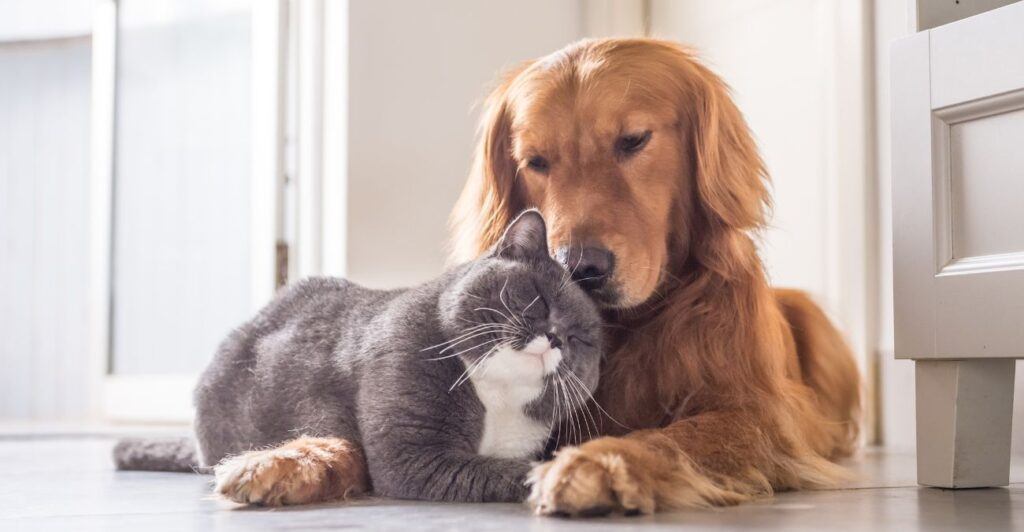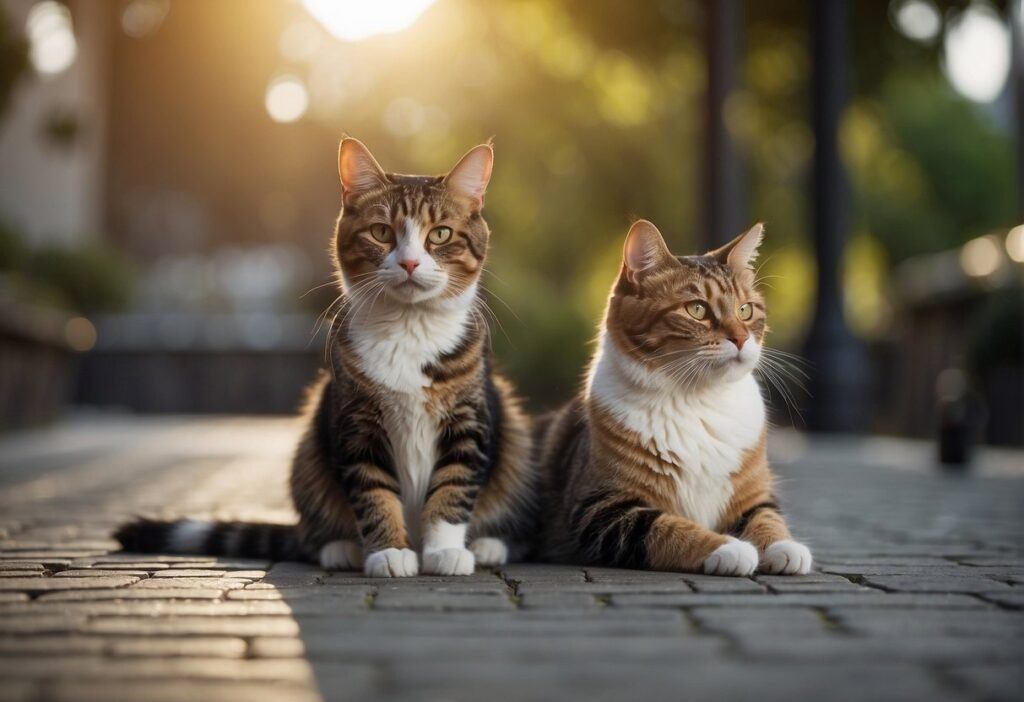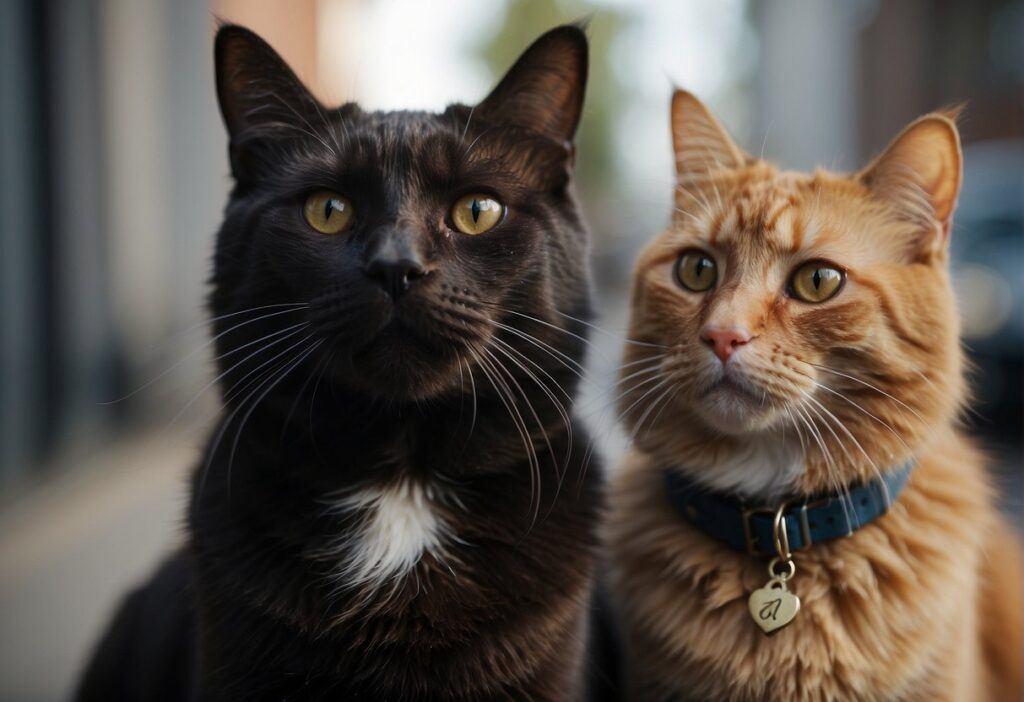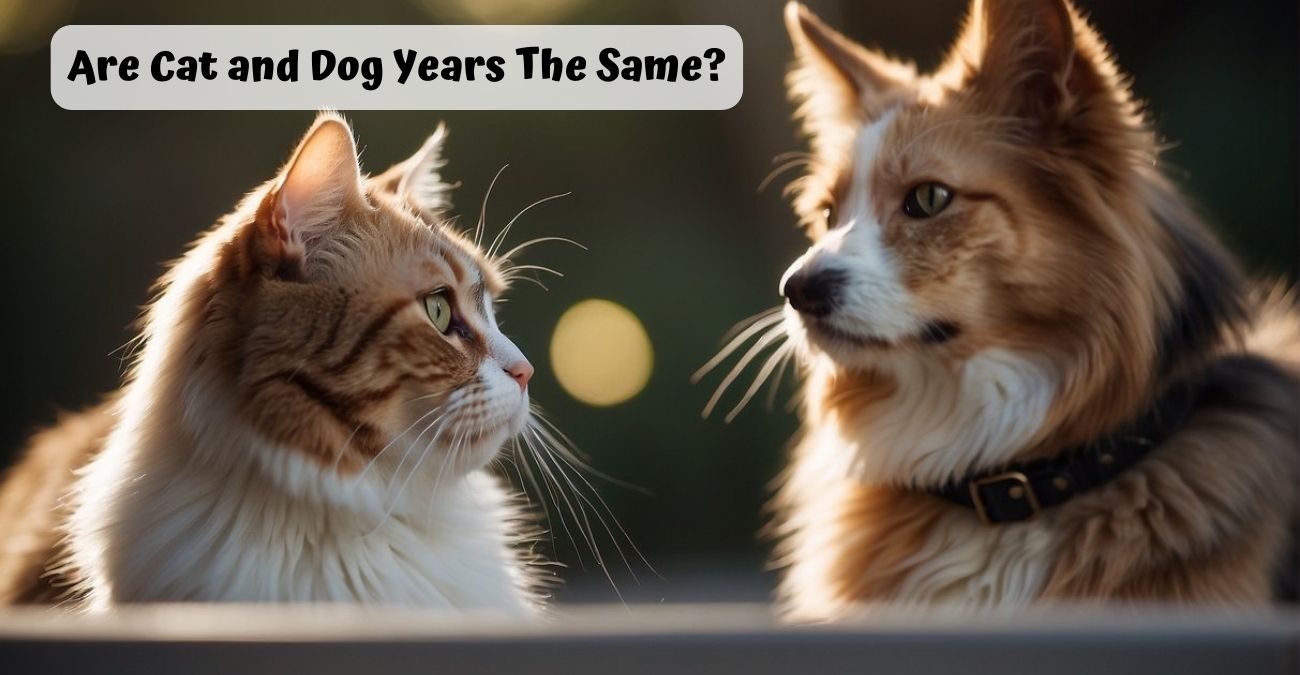When estimating the age of cats and dogs in human years, a common belief is that one year for a human is equivalent to seven years for a dog or cat.
Are cat and dog years the same?
No, cat and dog years are not the same. Each species ages at a different rate, so the method to calculate their age in human years varies.
The calculation of cat and dog years compared to human years is based on the rate at which these animals mature and age relative to humans. It’s a way to approximate their age in human terms.
For dogs, the traditional rule of “one dog year equals seven human years” is an oversimplification. The actual calculation is more nuanced:
- Dogs mature more quickly than humans in their first couple of years. For instance, the first year of a dog’s life is roughly equivalent to 15 human years.
- The second year of a dog’s life is about nine human years.
- After the second year, each dog year can be estimated as 4 to 5 human years, varying by size and breed. Larger breeds tend to age faster than smaller ones.
For cats, the calculation is a bit different:
- The first year of a cat’s life is approximately equal to 15 human years.
- The second year for a cat is about nine human years.
- After that, each additional year is around four human years.
However, this is a simplification and does not accurately reflect the aging process of pets. How cats and dogs age differs not only from humans but also from each other.
For instance, cats and dogs mature quickly in their early years, but the rate at which they age thereafter varies significantly between the two species.
Calculating The Difference Between Cat & Dog Years

A more nuanced approach is needed to calculate a cat’s age in human years than the ‘one size fits all’ method.
Cats are generally considered to have aged the equivalent of 15 human years by the end of their first year.
By their second year, they are roughly 24 in cat years, and thereafter, they age approximately four human years for every calendar year.
The calculation of dog years is more complex with dogs due to the variation in life expectancies based on breed and size.
Smaller breeds live longer than larger ones, resulting in different aging rates.
While the initial formula might be similar to that of cats, with dogs considered to be about 15 human years old by the end of their first year, the subsequent aging process requires considering the dog’s size and breed to accurately estimate their age in human years.
Understanding Cat Aging

Cat aging is distinct from that of humans and dogs, involving varied life stages and a life progression reflected in their health and behavior.
Comparing Cat and Dog Years
Calculating a cat’s age in human years differs from calculating a dog’s.
While both age at different rates than humans, the general rule suggests that the first year of a cat’s life is equivalent to approximately 15 human years.
By the end of the second year, a cat is typically akin to a 24-year-old human. Afterward, each year of a cat’s life is around four human years.
In contrast, dogs have a more variable rate of aging dependent on their size and breed but typically age faster than cats in their early years.
Equivalent Ages for Cats:
| Cat Age | Equivalent Human Age |
|---|---|
| One year | 15 years |
| Two years | 24 years |
| Three years | 28 years |
| Four years | 32 years |
| 5 years | 36 years |
Factors Influencing Cat Lifespan
A combination of genetics, diet, environment, and healthcare influences the average lifespan of a cat.
While the average lifespan typically ranges from 12 to 15 years, an indoor cat that is well-cared for can often reach into their late teens or even early twenties in human years.
Senior cats, classified as older than 11 years, require more attentive care to ensure a healthy life through their later stages.
It is important to understand that as cats reach different stages of life—from a 1-year-old young adult to a 2-year-old adult cat and through to senior years—they may encounter other health challenges associated with aging.
A cat age calculator can help determine a cat’s age in “human years,” but recognizing the signs pertinent to each stage of life can better inform caretakers of the care required.
For example, an older cat may need alterations in diet or more frequent veterinary visits to maintain a healthy life.
A cat’s birthday is more than a celebratory date; it’s a checkpoint for understanding and ensuring the cat’s well-being as it progresses through its years of life.
Cat Age to Human Years

When comparing a cat’s age to human years, it’s important to understand that cats age more rapidly in their early years and more slowly as they mature.
Interpreting Cat Years
One must approach converting a cat’s age into human years with a nuanced perspective, as the correlation is not a straightforward multiple.
Contrary to popular belief, one cannot simply multiply a cat’s age by seven to find its equivalent in human years. During their first two years, cats mature more quickly than humans.
Generally, the first year of a cat’s life equals about 15 human years, with the second year equating to about nine additional human years.
After this point, each additional year of a cat’s life is roughly equivalent to four human years.
Cat Age Milestones
The milestones in a cat’s life can be illuminated further with the aid of a cat age chart. Here’s an approximation of a cat’s age in human years:
- 1-year-old cat: Comparable to a 15-year-old human.
- 2-year-old cat: Approximately similar to a 24-year-old human.
From the age of two, a cat’s equivalent age in human years can be estimated as:
- Four human years for every one cat year.
For illustration:
- A 4-year-old cat would be around 32 years old in human years.
- A 7-year-old cat matches closely with the age of a seven-year-old child.
Using this framework, one can understand the approximate human age of their pets, charting the journey from kittenhood to senior status.
Health and Life Expectancy
Understanding the health and life expectancy of cats and dogs is critical for providing the appropriate care throughout their lives.
Factors such as whether they are indoor or outdoor pets, their diet, and disease prevention measures significantly influence their longevity and well-being.
Caring for Aging Cats
Cat aging is not an exact science, as the rate can vary depending on lifestyle and genetics. Indoor cats often live longer than outdoor cats due to fewer risks and controlled environments.
Indoor cats typically live 12-15 years, while outdoor cats have a shorter life expectancy due to risks like accidents and disease exposure.
- Life Expectancy Factors:
- Indoor Cats: Higher due to safety and controlled diet.
- Outdoor Cats: Lower exposure to risks and predators.
A balanced diet and regular veterinary check-ups are vital to maintain a healthy cat during their senior years.
Regular visits to the vet can help detect and prevent medical problems early, including kidney disease, which is common in aging felines.
- Disease Prevention:
- Regular vet check-ups.
- Monitoring for signs of illness.
Recognizing Age-Related Changes
Cats reach sexual maturity around six months but don’t enter their golden years until they are much older.
Observing behavioral changes can lead to early detection of health issues. Signs to monitor in senior cats include:
- Physical Changes:
- Muscle mass loss.
- Weight loss or gain.
- Behavioral Changes:
- Decreased activity.
- Changes in sleep patterns.
Weight loss in later life should not be taken lightly as it often indicates underlying health issues.
Keep an eye on a senior cat’s eyes and teeth; a haze in the cat’s eyes or yellow stains and tartar build-up on teeth may suggest health problems.
Inspecting your cat for any abnormalities should be part of a routine.
A healthy diet tailored to aging cats and appropriate exercise can help preserve muscle mass and contribute to a longer, healthier life.
- Monitoring Health:
- Regular physical examinations.
- Observing for vision and dental problems.
Related: Maine Coon Cat Lifespan
Breed-Specific Age Considerations
Age in pets is influenced by breed, especially when comparing small to large breeds where life expectancy and developmental milestones vary significantly.
Small vs. Large Breeds
Small dog breeds often have longer lifespans than their larger counterparts. A smaller dog, such as a Chihuahua, can live into their teens, while a larger dog, like the Great Dane, typically has a shorter life span.
This discrepancy reflects the observation that larger dogs age more quickly, which means that an additional year in a large dog’s life equates to more than an additional year in a small or medium dog’s life.
Notable Breed Lifespans
According to the Guinness Book of World Records, the oldest living cat on record was Creme Puff, who lived to be 38 years old, showing that cat breeds can have long lifespans.
In contrast, dogs age differently, and while young cats might not show as much disparity among breeds, middle-aged dogs can show significant differences in health and weight gain.
For instance, a Great Dane might be considered elderly by 6-8 years, whereas a smaller breed may not reach middle age until 10-12.
Differences like these are important for cat owners and pet parents to consider when caring for their companions.
Introducing Cory Haasnoot, a devoted father, loving husband, and enthusiastic cat lover. As a key content creator for CatFurLife.com, Cory blends his family values and passion for felines into engaging and informative content. He brings a unique perspective to the site, sharing cat care tips and how cats can enrich family life and bring joy to households.


Thanks for putting this together! Always love finding resources for fellow cat lovers.
There’s also a free cat-to-human age calculator I built: https://catyearstohuman.com.
Might be handy for anyone curious about their kitty’s “real age.” 🐾